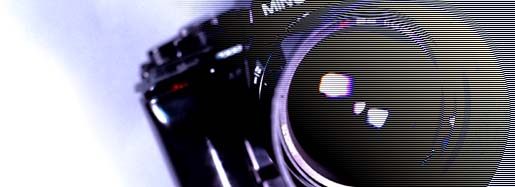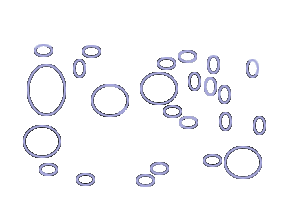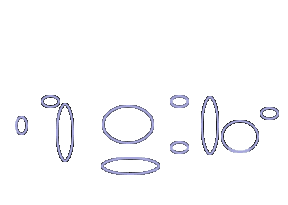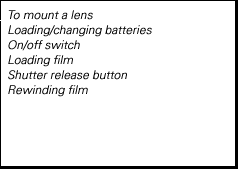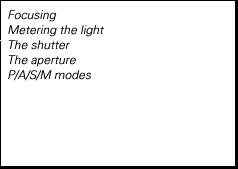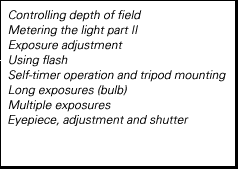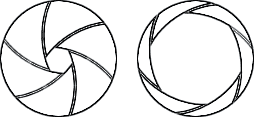The aperture
The aperture is the other of the two things controlling how much light that hits the film (the first one was the shutter). It consists of a variable opening inside the lens. While the shutter regulates the time span of the film's exposure to light, the aperture controls the amount of light that is hitting the film during that time period. Hard to understand? Think of it as a water pipe (the aperture) regulated by a valve (the shutter). A different thickness of water pipe will give different amounts of water (light hitting the film) during the time the valve is opened. A thin pipe, open for a longer time, will give the same amount of water as a thicker pipe, open for a shorter time. In the same way, the shutter and the aperture are just two ways of controlling the amount of light hitting the film. Of course it is possible to use a thick pipe and keep the valve open for a long time, too. Sometimes you need lots of water for a long time... OK, I'll let go of the analogy now! When it is dark, you may want to use every little bit of available light, and that means both keeping the lens wide open and using a long shutter speed.
Creative use of the aperture
One may now wonder what the purpose is of having two completely interchangeable ways to control the same thing ("the thing" being the amount of light hitting the film). The answer is that there are other side effects associated with the two methods. Creative use of the shutter will, as we have seen, be of use when trying to photograph moving objects. The aperture, on the other hand, controls the range (depth) of the sharpness in the picture. This is commonly referred to as Depth Of Field or simply shortened to DOF. A small (shallow) DOF means that the subject you are focusing on stands out against a defocused, blurry background. A large (deep) DOF, on the other hand, means that more things in the picture will be sharp. The effect can easily be seen in the example shots here besides.
Typical situations
A prime example for shots with large DOF is a landscape shot. Here, you want everything in the picture to appear sharp, so you reduce the aperture size. This is called "stopping down" the aperture.
Another typical example is a portrait headshot. The facial features of the model is probably the most interesting thing in the picture, so you could use a relatively small DOF to isolate the main subject and turn the background and foreground into a nice, creamy blur.
Controlling the aperture on a 9000
On many cameras, mainly older ones, the aperture is controlled directly on the lens mechanically. Turn a ring on the lens and the aperture closes and opens. On the 9000, as well as on all other Minolta autofocus cameras and most lenses, the aperture is controlled electronically by the camera. Use the lever on the front side of the camera, just above the silvery lens release button. The lever can slide in two directions, up and down. "Up" means a smaller number, "down" means a larger. The aperture setting changes rapidly if the button is held in one direction. Check the camera display, but be sure to activate the meter by resting your finger slightly on the shutter release button.
The catch
This is all fine and dandy, but here comes the catch -- a small aperture corresponds to a large DOF which corresponds to a large number. A very small opening can be (typically) F/22 while a very large opening can be (typically) F/1.4, and this is somewhat counterintuitive and confusing. It is easier if we link together the concept of DOF with the numbers and forget about the actual opening in the lens for a while. A small number corresponds to a small DOF. A large number corresponds to a large DOF. This is probably the single most confusing thing about photography for a novice.
- A small number corresponds to a small DOF. A large number corresponds to a large DOF.
- A small number also corresponds to a large opening, meaning large light transmission. And vice versa.
- The 9000's aperture control works in half stops at all time. Half-stop steps are, if available on the lens: 1, 1.2, 1.4, 1.7, 2, 2.4, 2.8, 3.5, 4, 4.5, 5.6, 6.7, 8, 9.5, 11, 13, 16, 19, 22, 27, 32, 38, 45, 54, 64.

